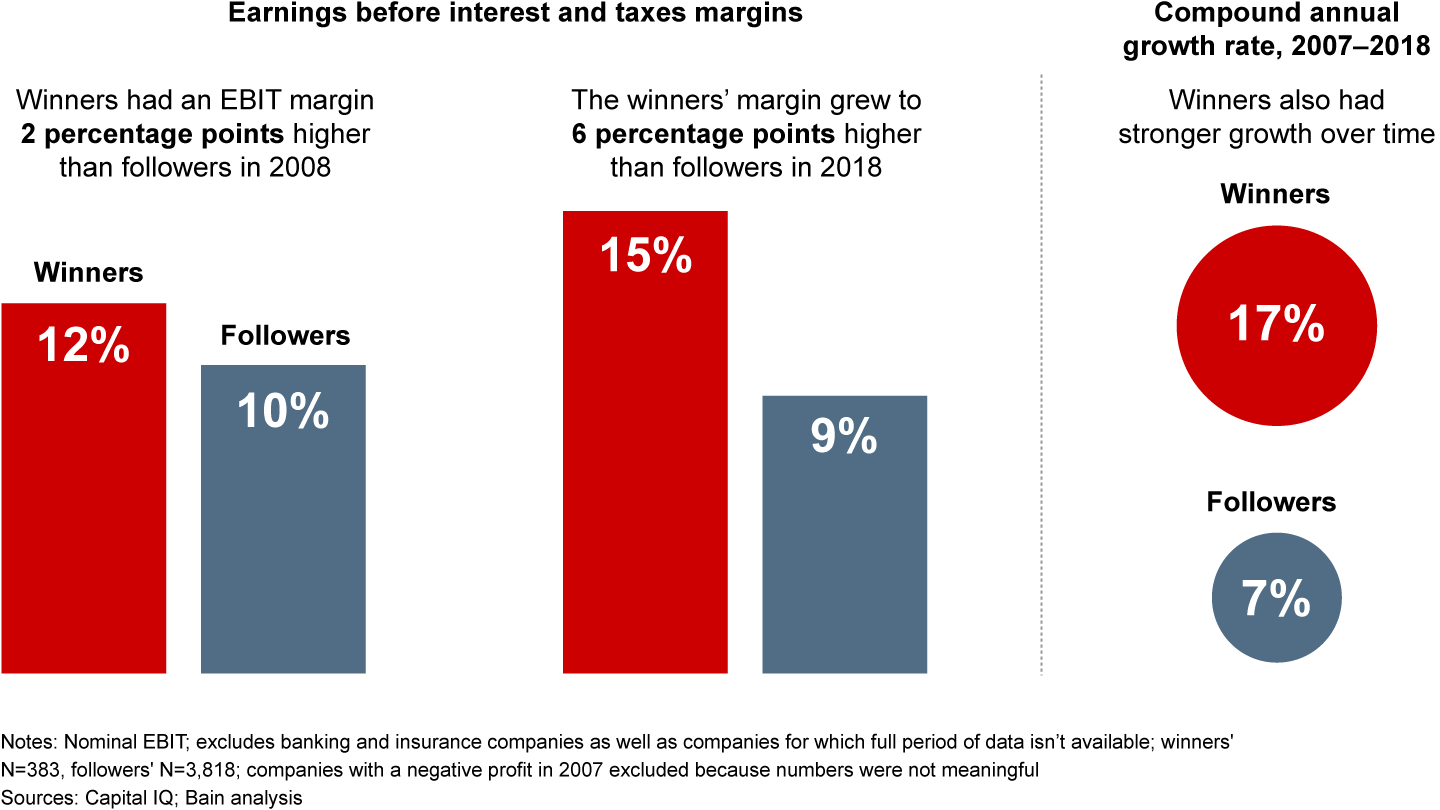Brief

Executive Summary
- Research shows industry leaders make bold moves during a recession, widening the performance gap with peers.
- The exact timing and duration of a recession matters less than being ready to seize the moment.
- Top boards pressure test the portfolio against changing market conditions and prepare for future scenarios.
In virtual board meetings around the globe, directors are feeling the full weight of an unpredictable future. The Covid-19 crisis is arguably the biggest test of leadership for an entire generation of executives. It has exposed underlying fragility in operations and supply chains in almost every industry, affecting top performers as well as struggling firms. It also has accelerated powerful, disruptive trends, including digitalization, shifts in customer behavior and industry consolidation. That’s a tsunami of change for the leaders of any organization.
Many companies were starting to tackle these challenges before the pandemic hit, but few were prepared for such an abrupt leap into the future. As a result of Covid-19, the world’s economy will look vastly different in 2021 than it did in January 2020. Boards that vigorously support and challenge leadership teams now as they focus on a post–Covid-19 strategy can make the difference between companies that rebound through the recovery and those that fall behind.
It’s important to seize the moment: Research shows that industry leaders redouble their efforts in difficult times to strengthen their market position and that complacency carries a cost. In past recessions, the gap between the best and worst performers widened significantly (see Figure 1). Leadership teams that navigated through the 2007–2009 financial crisis still vividly recall how it played out. Companies with strong liquidity played offense, pursuing M&A to build scale and scope, or doubled down on innovation. They also used creative deal-making options, such as asset swaps or partnerships, to conserve capital while pursuing their objectives. Some weaker companies sold assets to strengthen their core businesses. In times of change and disruption, the best management teams create a new path to market leadership.


The fundamentals of corporate strategy become even more relevant in fluid and fast-evolving business environments—and the stakes are higher. In turbulent times, successful leadership teams focus on three key actions: They build a future-ready portfolio with the businesses and capabilities that position the company for success beyond the crisis, they seek mergers and partnerships to bolster the company’s competitive position, and they adapt their equity story to a changing world and communicate it to stakeholders.
That combination defines strong leadership in a time of crisis.
The role of the board
A board of directors’ highest calling is guiding a management team through a crisis. Directors have a vital role in turbulent times, protecting the business, accelerating through the recovery and planning to retool for the future. The best boards look far beyond immediate challenges. They pressure test the management team’s assumptions about the resilience and long-term sustainability of the firm (see Figure 2).
Successful boards reflect deeply about the portfolio and organization they will need in the future and take early action. They anticipate evolving market and customer trends, strengthen existing businesses and build new ones. Looking ahead, they invest in innovation, identify capabilities critical for success, build the appropriate talent pipeline, and ensure adequate liquidity for multiple scenarios.
Five questions can help boards start working with their management teams to define a strategy for the new post–Covid-19 world.
How resilient and sustainable are our portfolio and financial position? Skilled boards and management teams work together to assess each business critically and measure it against evolving market conditions. They know that some elements of customer value will shift irrevocably. In many industries, companies will face changing customer expectations. The key battlegrounds for businesses may shift as new markets develop, creating threats and opportunities. Leaders invest more in the businesses they believe can command strong leadership positions in the future; they also review the tradable assets and marginal businesses and divest units unlikely to thrive in the future.
The uncertainty surrounding a post–Covid-19 world makes it difficult to think years ahead, but prudent boards and management teams create a range of scenarios and pressure test the balance sheet and liquidity position against each of them. Effective boards train a sharp eye on the company’s financial health, business continuity and risk-mitigation plans, and they make sure that the CEO and management team have what they need to protect the company.
They also push the management team to rediscover the art of scenario planning. This involves looking at a range of industry scenarios based on potential disruptions. Two perspectives are key. The first is a future-back assessment of changing industry, market and customer trends that will result in new ecosystems, customer preferences, profit pool shifts and rules of the game. The second perspective derives scenarios based on broader forces, such as macroeconomic swings, political and regulatory changes, or climate change, that could alter a company’s competitive position. Leaders identify signposts that may flash a warning one to two years in advance of specific scenarios and allow management teams to make an early course correction.
What is the appropriate allocation of capital and resources to strengthen the most attractive businesses and fund new bets? For companies lucky enough to have come through the Covid-19 crisis this far with little damage to the balance sheet, relieved leadership teams may feel it’s prudent to maintain a defensive posture and avoid changing tack. But as past recessions have shown, when crises deepen, winning boards go bold.
Recognizing that a downturn creates an opportunity to leapfrog the competition, leaders set about acquiring strategic capabilities and building a long-term advantage. Companies with a competitive business in strong markets should consider investing heavily to help consolidate that lead. Businesses in a less competitive position should evaluate the firm’s ability to invest and create value.
Take the example of Samsung, which used the 1997 Asian financial crisis as a catalyst to refocus its portfolio on core technology-intensive businesses and build a global leadership position. Between 1993 and 1999, the company invested in new capabilities, increasing R&D spending by 200% and global advertising by 400%. A decade later, during the Great Recession, the company invested heavily in innovation and branding to widen the gap with peers that were cutting costs. It increased R&D spending by 8% from 2008 to 2009 and quintupled the number of patents filed in the US. By 2010, Samsung had doubled its profits compared with the precrisis level, and by 2012, its global brand value as a technology company had risen to No. 9 from No. 21 in 2007.
Consumer goods multinational Reckitt Benckiser used the dotcom bubble downturn in 2000 as well as the 2007–2009 recession to invest in brands and digital innovation to outperform peers that underinvested. Focusing on a few high-growth categories, it rapidly rolled out 19 power brands into new geographies. It introduced a new innovation for each power brand every six months and invested heavily in digital tools to improve customer experience and market effectiveness. The gains were significant: Reckitt Benckiser’s earnings before interest and taxes margin rose to 26% in 2010, up from 14% in 2000, and it posted a compound annual growth rate from 2000 to 2010 of 7.4%.
How can the firm make the most of M&A opportunities? For corporate leaders, the exact timing and duration of a recession matters less than being ready to seize the moment early on, when they have more options. Getting ahead of the curve avoids the painful alternative—namely, being forced to react hastily in a crisis. Successful management teams take advantage of the broader range of mergers and acquisitions that are available at lower multiples as well as structuring options such as asset swaps. Once they have reviewed the portfolio and assessed the strength of the balance sheet, boards and CEOs are well equipped to review a list of potential acquisitions and partnerships that would strengthen the business by adding scale or new capabilities or both. They also revisit M&A targets that the company explored without success before the crisis in case conditions have changed.
A recession offers well-prepared leaders the chance to go on the offensive, using M&A and partnerships to gain scale. Many companies made industry-defining deals during the Great Recession. Stanley Works, for example, took advantage of a lower valuation to acquire Black & Decker in 2009 for $4.5 billion, doubling its scale and making it a global leader in tools. Wielding its strong integration capabilities, the management team at Stanley Works reduced costs and increased the margin in the tools business to 11% in 2010, up from 8% one year earlier.
Creative leadership teams use asset swaps or noncash transactions to limit capital outlays while strengthening their core businesses. Take the cash-free merger in October 2019 between Hitachi and Honda Motor, combining four of their car parts businesses. The deal created a leading global components supplier with about $17 billion in sales, and it doubled Hitachi’s scale in the parts business with no capital investment.
What future ecosystems does the company need to be part of, and do we have the capabilities to succeed in them? An array of evolving technologies will substantially alter customer behavior and demand in many sectors. Leaders determine which portfolio businesses are becoming part of important new market constellations and whether the firm has a parenting advantage or differentiated capability in that sector. In the midst of the Covid-19 crisis, for example, Daimler and Volvo announced a €1.2 billion 50–50 joint venture to develop and produce fuel cell systems for trucks. The aim of the venture is to decrease development costs, speed innovation and bring hydrogen-powered heavy-duty vehicles to the market by the second half of the decade.
How do you evolve the firm’s equity story to reflect the longer-term strategy and address investors’ concerns? As the recession deepens, investors increasingly are growing anxious about the level of debt many companies hold. The Covid-19 crisis has exposed weak balance sheets, and highly leveraged companies face a far more difficult environment. Many boards are also recognizing that a short-term outlook focused on shareholder returns can only make the situation worse.
In exercising their fiduciary responsibility, top boards ensure that the balance sheet is strong enough to withstand a range of scenarios and robust enough to support management’s plan. They also evolve their equity story in a way that highlights leadership and long-term vision instead of short-term quarterly results. That involves addressing investor concerns, sharing a view of the business model’s resilience in various scenarios, and detailing opportunities to go bold and accelerate in the recovery.
In the last financial crisis, the investment bank Jefferies struggled with liquidity concerns that prompted a rating downgrade. The CEO acted quickly and with full transparency, closing down illiquid positions and publicly addressing investors’ concerns in a six-page letter. His open approach restored investor confidence and prompted a rebound in the company’s share price as its competitive position and turnover steadily improved.
A stamp on the future
Effective boards work with management teams to create credible scenarios, challenge them to reassess portfolio choices, and prod them to think through the implications of capital and resource allocation. That tandem helps ensure that the leadership team is equipped with strong working hypotheses about the dynamics in their industry and a winning strategy to outperform.
Great boards go one step further: They ensure that companies retool for a new world by defining stretch ambitions, pushing leadership teams to play offense, and confirming the company has the appropriate capabilities and talent. Above all, they make sure the operating model and balance sheet will support their ambitions. Every action in a crisis can have an outsized effect. The best boards know that their actions and decisions will become part of the firm’s narrative for many years to come, defining its culture and reputation.